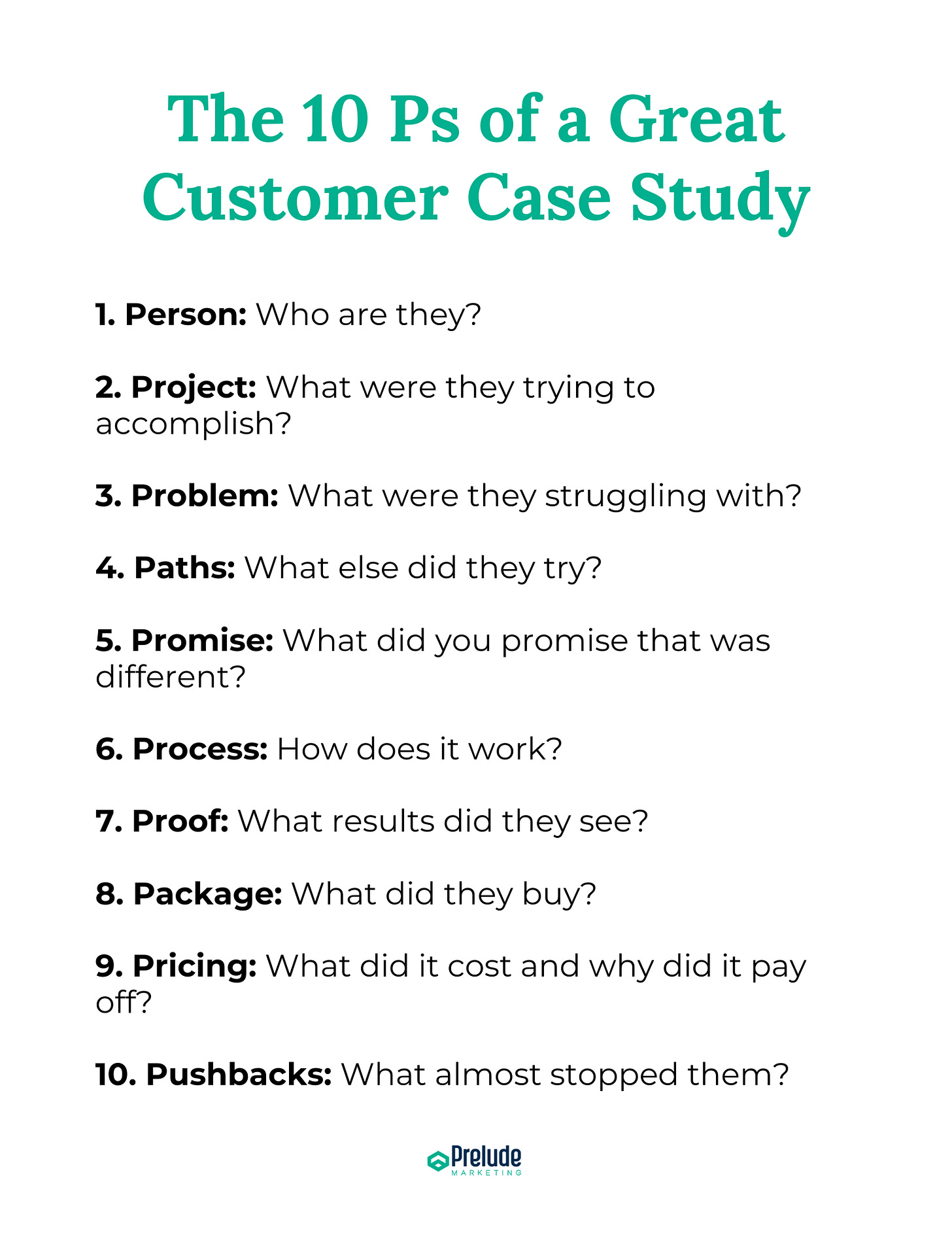The 10 P's of a Great Customer Case Study
A framework for capturing the strategic intelligence that drives business decisions
Most companies treat case studies like marketing trophies—pretty stories to sprinkle on their websites.
But this is backwards thinking.
Your best customer case studies aren't just marketing assets. They're strategic intelligence that should inform everything from product development to sales strategy.
The Problem: Shallow Case Studies
Most case studies answer four questions:
Who was the customer?
What problem did they have?
What is your solution?
What results did they get?
That might be sufficient for a simple marketing asset, but these surface-level stories miss the insights that can drive internal business strategy.
What alternatives did they consider before choosing you? What almost stopped them from buying? How did they justify the investment internally?
The answers to these questions reveal your competitive advantages, common objections, and what matters to buyers.
The 10 P's Framework for Case Studies
Here's my framework for capturing everything that matters in a customer case study. These 10 elements give you the strategic intelligence to replicate the success across your business:
1. Person: Who are they?
Describe the customer's role, company type, and growth stage. Capture the champion's title and responsibilities, company size, and industry, plus any behaviors or mindset that made them the internal driver for change.
2. Project: What were they trying to accomplish?
Describe the workflow, initiative, or situation in which the customer applied your solution. Document why this project mattered to the business, what was at stake if it failed or succeeded, and how they planned to measure success internally.
3. Problem: What were they struggling with?
Explain the challenges they faced before working with you. Cover functional struggles (specific inefficiencies), emotional toll (stress, frustration), and the trigger moment that forced them to seek change. Include what they were using before that wasn't working.
4. Paths: What else did they try, and why didn't it work?
List other options they considered, including internal fixes, competitors, tools, or doing nothing. Document their selection criteria and dealbreakers that eliminated alternatives. Capture why you cleared hurdles others couldn't.
5. Promise: What did you promise, and how was it different?
Explain your unique point of view and value proposition. Document the specific language or belief shift that reframed the customer's thinking, what they expected to achieve, and how you reduced their perceived risk of moving forward.
6. Process: How does it work?
Walk through the key steps in your delivery from the customer's perspective. Capture their onboarding experience, what they valued most in the working relationship, and how the process adapted to their specific needs.
7. Proof: What results did they see?
Share the outcome with specific metrics and qualitative shifts. Document the early win that validated their decision, how quickly they saw value, what they can do now that wasn't possible before, and any lasting changes in their workflows.
8. Package: What did they buy?
Clarify the scope, deliverables, or tier they selected. Explain why this package was right for their needs and why other options weren't suitable. Include specific outputs or outcomes that were part of the engagement.
9. Pricing: What did it cost and why did it pay off?
Document whether cost was a concern, how they justified the investment internally, and who had to approve the budget. Capture their ROI logic and why the results outweighed the cost.
10. Pushbacks: What almost stopped them?
Document the objections, perceived risks, or internal resistance they had to overcome. Include concerns about timing, budget, or switching costs, plus how they achieved internal alignment among different stakeholders.
Beyond Marketing: Strategic Applications
A well-documented case study using this framework becomes intelligence for:
Product Development: What features drove the decision? What didn't matter?
Sales Strategy: Which objections come up consistently? What proof points close deals?
Marketing Messaging: What language resonates? Which problems create urgency?
Customer Success: What outcomes do customers value most? When do they expand?
Competitive Strategy: What alternatives are you competing against?
Start With Your Best Story
Pick one customer success you'd gladly repeat 100 times over. Interview them to extract these 10 elements. Document their answers thoroughly.
You'll be surprised at how much strategic intelligence emerges from a single well-documented story.
Most companies have the data. They just haven't asked the right questions to extract it yet.
Want my 10 P's Case Study Interview Guide? It includes specific questions to extract all this strategic intelligence from your customer interviews.
Paid subscribers can access the interview guide, as well as my Case Study Writer custom GPT, which creates a multi-page case study from an interview transcript here:



